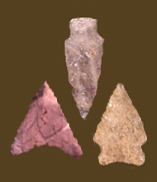
Projectile Points Search By Type Name
|
|
HARDAWAY-DALTON
Chronology Description Haft Element: The base is usually deeply concave, ground, and smooth. Basal thinning that produces flute-like scars is common. The haft element can have either incurvate lateral edges with outward flaring ears, or straight lateral edges with ears that point down (Daniel 1998). On some Maryland examples, the basal concavity is more shallow than on typical Southeastern specimens, and the ears somewhat less pronounced (Brown 1979). Size: Coe’s 1964 type description indicated that length ranged from 50 to 80 mm, with an average of 60 mm; width ranged from 30 to 40 mm, with an average of 35 mm; and thickness ranged from 5 to 8 mm, with an average of 7 mm. However, in a Maryland sample of seven points identified as Hardaway-Dalton, sizes were much smaller. Lengths ranged from 26.9 to 46.1 mm, with a mean of 36.5 mm and a standard deviation of 7.16 mm. Widths were between 16.3 and 26.6 mm, with a mean of 21.09 mm and a standard deviation of 4.2 mm. Thicknesses were 4.5 to 7.4 mm, with a mean of 5.7 mm and a standard deviation of 0.95 mm (Brown 1979). Although these size distinctions could reflect regional variation, they may be the result of differences in how the two investigators identified the Hardaway-Dalton points in their collections. Technique of manufacture: Initially, soft percussion flaking, followed by fine retouching. Many examples exhibit fine serrations, most commonly seen on points that show re-sharpened edges. The base and shouldered sides are thoroughly ground. Material: Most Hardaway/Hardaway-Dalton varieties found in Maryland are made of jasper or chert, but quartz, quartzite, and rhyolite have been reported (Brown 1979; Steponaitis 1980; Wanser 1982). Discussion Defined in Literature Other Names Used References |

|
Thank you for visiting our website. If you have any
questions, comments, Copyright © 2002 by |

|

 Defining Attributes
Defining Attributes